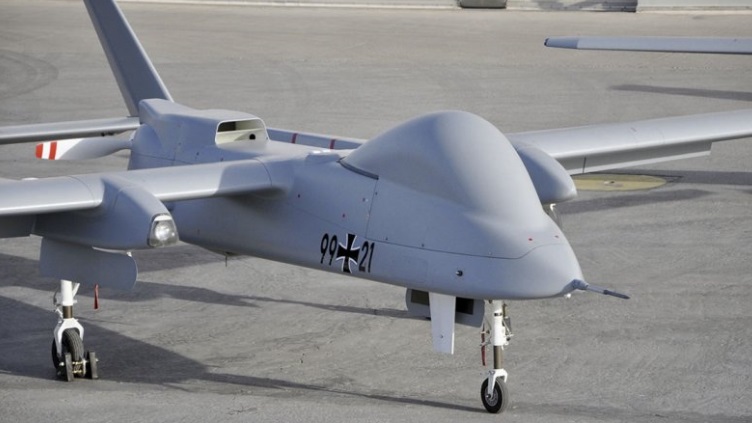
Robohub.org
The Drone Center’s Weekly Roundup: 6/5/17

A German Heron 1 UAV. Credit: Airbus Defence and Space
May 29, 2017 – June 4, 2017
News
A German court has thrown out a protest filed by U.S. drone maker General Atomics Aeronautical Systems over the German military’s decision to acquire the Israel Aerospace Industries Heron TP drone over the U.S. firm’s Reaper. The decision by the Oberlandesgericht, the country’s high court, allows the Bundeswehr to proceed with the planned acquisition of five Heron TPs, a medium-altitude long-endurance surveillance and reconnaissance drone. (DefenseNews)
Commentary, Analysis, and Art
At War on the Rocks, Jonathan Gillis argues that the U.S. military is not prepared for a future filled with enemy drones.
Also at War on the Rocks, Michael Horowitz considers the ways in which emerging technologies will shape how the U.S. military fights in future conflicts.
In a series of articles at Breaking Defense, Sydney J. Freedberg Jr. looks at how the U.S. military is integrating artificial intelligence into its operations.
At Defense One, Patrick Tucker writes that Poland is planning to invest in small, lethal drones rather than large unmanned systems like the Reaper.
A study by the University of Washington found delivery drones tend to produce fewer carbon emissions than trucks when traveling short distances. (UW Today)
At TechCrunch, Brian Heater argues that the DJI Spark foldable drone is not quite the “mainstream” drone that it was made out to be.
At Popular Mechanics, Joe Pappalardo considers the role that small, disposable drones will play in the future of warfare.
At ArsTechnica, Sean Gallagher recalls his role in the U.S. Navy’s early experiments with unmanned aircraft.
At the Montreal Gazette, Marc Garneau discusses the potential threat posed by drones to aircraft.
At the Washington Post, Michael Laris considers what is likely to happen in the wake of the federal appeals court’s decision to strike down the FAA’s drone registration rule for hobbyists.
At the Jamestown Foundation, Tobias J. Burgers and Scott N. Romaniuk look at how al-Qaeda learned to adapt to U.S. drone strikes.
The New York Times reports that a former head of the CIA’s drone program will now lead the agency’s Iran operations.
A paper in Remote Sensing offers a survey of the different systems and methods for using drones for marine mammal research. (MDPI)
A paper in Frontiers in Plant Science compares the use of drones and satellite images in monitoring plant invasions.
In Critical Studies in Security, Katharine Hall Kindervater argues that targeted killings are best understood within the context of a shift towards lethal surveillance.
In the Air & Space Power Journal, Lt. Col. Thomas S. Palmer and Dr. John P. Geis II argue that effective counter-drone weapons will be essential in future conflicts.
In the Naval War College Review, Jeffrey E. Kline considers how to effectively integrate robotics into the fleet while recognizing fiscal constraints.
Know Your Drone
Researchers at the Charles Stark Draper Laboratory and Howard Hughes Medical Institute have created a system that turns live dragonflies into steerable drones. (Gizmodo)
A team at the University of Sherbrooke has developed a solar-powered drone than can autonomously land on lakes to recharge its batteries. (IEEE Spectrum)
U.S. firm Drone Aviation Holding Corp. unveiled an automated winch tethering system for DJI Inspire commercial multirotor drones. (Unmanned Systems Technology)
Amazon has been awarded a patent for a shipping label that doubles as a parachute for items delivered by drone. (GeekWire)
Meanwhile, Walmart has been awarded a patent for a system that uses blockchain technology to keep track of delivery drones. (CoinDesk)
The Office of Naval Research is developing a drone that can detect buried mines for use in amphibious landings. (Shephard Media)
Apple announced that its education programming App, Swift Playgrounds, will soon support code-writing for robots and drones. (The Verge)
Belorussian firms presented a range of new military unmanned aircraft at the MILEX 2017 exhibition in Minsk, including the Belar YS-EX, a medium-altitude long-endurance system. (IHS Jane’s 360)
In a test flight, China’s Caihong solar-powered ultra long-endurance drone reached an altitude of 65,000 feet. (The Sun)
Defense firm Lockheed Martin successfully completed a beyond line of sight pipeline inspection operation with its Indago 2 commercial multirotor drone. (Unmanned Aerial Online)
Robot maker SMP Robotics unveiled the S5 Security Robot, an unmanned ground vehicle. (Unmanned Systems Technology)
In a test, the U.S. Army used two Raytheon Stinger anti-aircraft missiles to intercept two drones. (Press Release)
The U.S. Special Operations Command has completed testing for its Joint Threat Warning System sensor for the Puma hand-launched tactical drone. (Shephard Media)
Aerospace firm Russian Helicopters is developing a fixed-wing vertical take-off and landing drone. (Shephard Media)
The U.S. Army is planning to test its autonomous trucks on a public highway in Michigan later this month. (Voice of America)
Texas Instruments has designed two circuit-based subsystems that it claims could increase the efficiency of battery-powered drones. (Drone Life)
Drones at Work
In a proof of concept demonstration, Drone Dispatch delivered a box of donuts to a customer by drone in Colorado. (CNET)
The organizers of the Torbay Airshow in the U.K. banned the use of drones at the event. (Devon Live)
Police in Snellville, Georgia are investigating various reports of a drone being used to spy on residents in their homes. (WSBTV)
Officers from the Stafford County Sheriff’s Office in Virginia used a drone to find an armed suspect. (WTOP)
The Albany County Sheriff’s Office in New York has acquired a drone for a range of operations. (Albany Times Union)
North Dakota’s governor has established a task force to support the development of counter-drone technologies. (Press Release)
The Israel Defense Forces is equipping infantry, border defense, and combat intelligence corps units with DJI drones. (Times of Israel)
A Russian bank plans to begin using drones to deliver cash to customers. (Forbes)
Industry Intel
Speaking at the Code Conference, Intel CEO Brian Krzanich said that Intel will not develop a consumer drone. (Recode)
Snap, the social media company that owns Snapchat, has acquired Ctrl Me Robotics, a California-based drone startup. (Buzzfeed)
The Australian Ministry of Defense announced that it will invest $75 million in small unmanned aircraft systems, including the AeroVironment Wasp AE, for the Australian Army. (Press Release)
The Netherlands Ministry of Defence selected the Insitu Integrator to replace the Insitu ScanEagle. (Unmanned Systems Technology)
The U.S. Army awarded Six3 Advanced Systems a $10.5 million contract to design and develop a prototype for a squad of human and unmanned assets. (DoD)
Three German firms, ESG Elektroniksystem und Logistik, Diehl Defence and Rohde & Schwarz, have partnered to market the Guardion counter-drone solution. (Shephard Media)
2G Robotics will provide the laser scanning, imaging, and illumination systems for the Norwegian Navy’s Kongsberg Maritime Hugin autonomous underwater vehicles. (Shephard Media)
France’s Direction Générale de l’Armement will take delivery of the Thales Spy’Ranger mini drone beginning in late 2018. (IHS Jane’s Defence Weekly)
For updates, news, and commentary, follow us on Twitter. The Weekly Drone Roundup is a newsletter from the Center for the Study of the Drone. It covers news, commentary, analysis and technology from the drone world. You can subscribe to the Roundup here.
tags: c-Aerial, Center for the Study of the Drone, Flying, Service Professional Military UAV, The Drone Center Weekly Roundup




